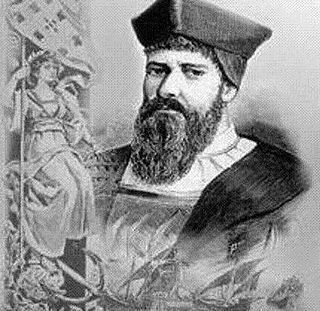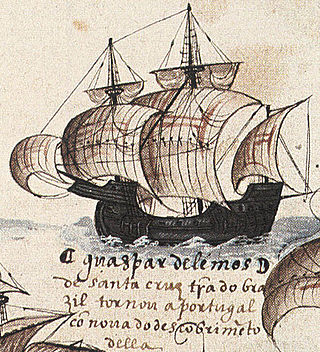Related Research Articles

D. Vasco da Gama, 1st Count of Vidigueira, was a Portuguese explorer and nobleman who was the first European to reach India by sea.

Pedro Álvares Cabral was a Portuguese nobleman, military commander, navigator and explorer regarded as the European discoverer of Brazil. He was the first human in history to ever be on four continents, uniting all of them in his famous voyage of 1500, where he also conducted the first substantial exploration of the northeast coast of South America and claimed it for Portugal. While details of Cabral's early life remain unclear, it is known that he came from a minor noble family and received a good education. He was appointed to head an expedition to India in 1500, following Vasco da Gama's newly opened route around Africa. The undertaking had the aim of returning with valuable spices and of establishing trade relations in India—bypassing the monopoly on the spice trade then in the hands of Arab, Turkish and Italian merchants. Although the previous expedition of Vasco da Gama to India, on its sea route, had recorded signs of land west of the southern Atlantic Ocean, Cabral led the first known expedition to have touched four continents: Europe, Africa, America, and Asia.

Duarte Barbosa was a Portuguese writer and officer from Portuguese India. He was a scrivener in a feitoria in Kochi, and an interpreter of the local language, Malayalam. Barbosa wrote the Book of Duarte Barbosa c. 1516, making it one of the earliest examples of Portuguese travel literature.
Diogo Dias, also known as Diogo Gomes, was a 15th-century Portuguese explorer. He was the brother of Bartolomeu Dias and discovered some of the Cape Verde islands together with António Noli.

João da Nova was a Galician-born explorer in the service of Portugal. He is credited as the discoverer of Ascension and Saint Helena islands.

Gaspar de Lemos was a Portuguese explorer and captain of the supply ship of Pedro Álvares Cabral's fleet that arrived to Brazil. Gaspar de Lemos was sent back to Portugal with news of their discovery and was credited by the Viscount of Santarém as having discovered the Fernando de Noronha archipelago in the Atlantic Ocean.
Fernão de Loronha, whose name is often corrupted to Fernando de Noronha or Fernando della Rogna, was a prominent 16th-century Portuguese merchant of Lisbon, of Jewish descent. He was the first charter-holder (1502–1512), the first donatary captain in Brazil and sponsor of numerous early Portuguese overseas expeditions. The islands of Fernando de Noronha off the coast of Brazil, discovered by one of his expeditions and granted to Loronha and his heirs as a fief in 1504, are named after him.

Pêro or PeroVaz de Caminha was a Portuguese knight that accompanied Pedro Álvares Cabral to India in 1500 as a secretary to the royal factory. Caminha wrote the detailed official report of the April 1500 discovery of Brazil by Cabral's fleet. He died in a riot in Calicut, India, at the end of that year.

Nicolau Coelho was an expert Portuguese navigator and explorer during the Age of Discovery. He participated in the discovery of the route to India by Vasco da Gama where he commanded Berrio, the first caravel to return; was captain of a ship in the fleet headed by Pedro Álvares Cabral who landed in Brazil. He died at sea, possibly off the coast of Mozambique, while returning from India in the 5th Portuguese Armada with Francisco de Albuquerque.

Portuguese maritime exploration resulted in the numerous territories and maritime routes recorded by the Portuguese as a result of their intensive maritime journeys during the 15th and 16th centuries. Portuguese sailors were at the vanguard of European exploration, chronicling and mapping the coasts of Africa and Asia, then known as the East Indies, and Canada and Brazil, in what came to be known as the Age of Discovery.
Gaspar da Gama, also known as Gaspar da India and Gaspar de Almeida, was an interpreter and guide to several Portuguese exploratory fleets. He was of Jewish origin and was probably born in Poznań in the Kingdom of Poland. In 1498 he was taken captive aboard Vasco da Gama's fleet on its return voyage to Portugal from India. He was known to speak multiple languages including Hebrew and Chaldean, as well as a mixture of Italian and Spanish.

The Second Portuguese India Armada was assembled in 1500 on the order of King Manuel I of Portugal and placed under the command of Pedro Álvares Cabral. Cabral's armada famously discovered Brazil for the Portuguese crown along the way. By and large, the Second Armada's diplomatic mission to India failed, and provoked the opening of hostilities between the Kingdom of Portugal and the feudal city-state of Calicut. Nonetheless, it managed to establish a factory in the nearby Kingdom of Cochin, the first Portuguese factory in Asia.
The Third Portuguese India Armada was assembled in 1501 upon the order of King Manuel I of Portugal and placed under the command of João da Nova. It was small compared to other armadas of the same type and was formed for commercial purposes. Nonetheless, it engaged in the first significant Portuguese naval battle in the Indian Ocean. The Third Armada discovered the uninhabited islands of Ascension and Saint Helena in the South Atlantic Ocean. Some speculate that it was the first Portuguese armada to reach Ceylon.
The 4th Portuguese India Armada was a Portuguese fleet that sailed from Lisbon in February, 1502. Assembled on the order of King Manuel I of Portugal and placed under the command of D. Vasco da Gama, it was the fourth of some thirteen Portuguese India Armadas, was Gama's second trip to India, and was designed as a punitive expedition targeting Calicut to avenge the numerous defeats of the 2nd Armada two years earlier.
Vicente Sodré was a 16th-century Anglo Portuguese knight of Order of Christ and the captain of the first Portuguese naval patrol in the Indian Ocean. He was an uncle of Portuguese explorer Vasco da Gama.

Pero de Ataíde or Pedro d'Ataíde, nicknamed O Inferno (Hell), "for the damage he did to the Moors in Africa", was a Portuguese sea captain in the Indian Ocean active in the early 1500s. He was briefly captain of the first permanent Portuguese fleet in the Indian Ocean, taking over from Vicente Sodré, and the author of a famous letter giving an account of its fate.
The naval Battle of Calicut was a military encounter between the 16 ships of the 4th Portuguese Armada and a fleet led by two Arabic corsairs formed under the orders of the Zamorin of Kozhikode.
The following lists events that happened during 1501 in India.
The following lists events that happened during 1500 in India.

The first arrival of European explorers to the territory of present-day Brazil is often understood as the sighting of the land later named Island of Vera Cruz, near Monte Pascoal, by the fleet commanded by Portuguese navigator Pedro Álvares Cabral, on 22 April 1500. Cabral's voyage is part of the so-called Portuguese discoveries.
References
- ↑ K. J. P. Lowe, "Cultural links between Portugal and Italy in the Renaissance", p.8, Oxford University Press, 2000
- ↑ "The voyage of Pedro Álvares Cabral to Brazil and India: from contemporary documents and narratives" p.146, Issue 81 of Works issued by the Hakluyt Society, William Brooks Greenlee, Asian Educational Services, 1995, ISBN 81-206-1040-7
- ↑ Teresa Lacerda "Os Capitães das Armadas da Índia no reinado de D. Manuel I – uma análise social". Lisboa, 2006 (in Portuguese)
- ↑ Sanjay Subrahmanyam, "The Career and Legend of Vasco da Gama", p.182, New York: Cambridge University Press, 1997, ISBN 978-0-521-47072-8